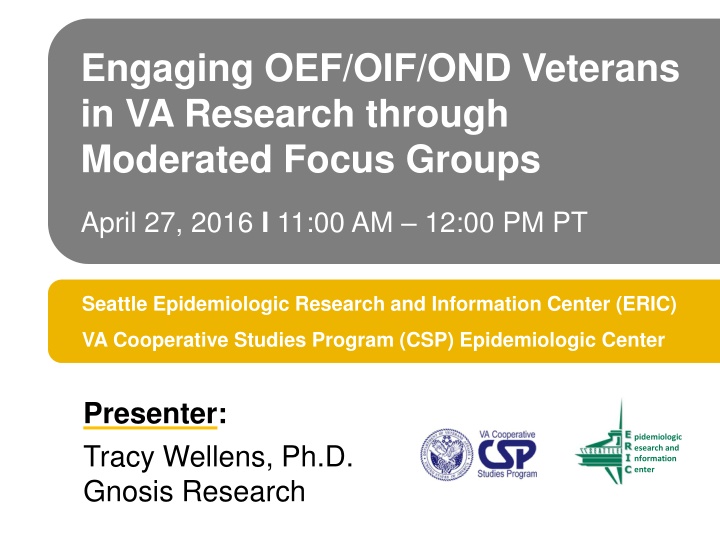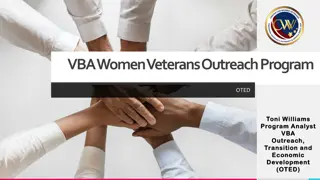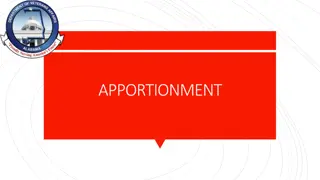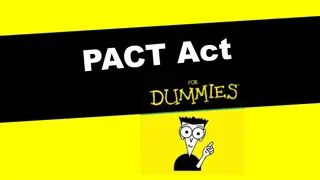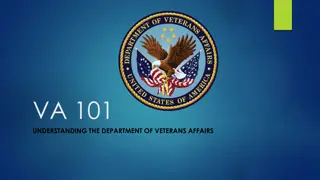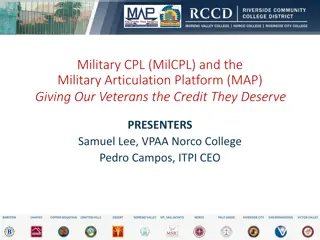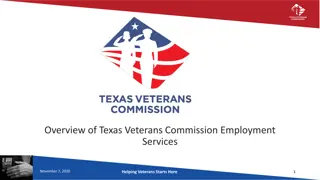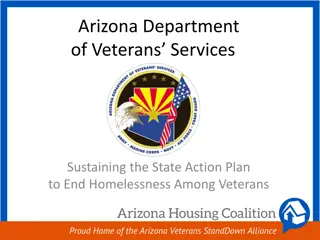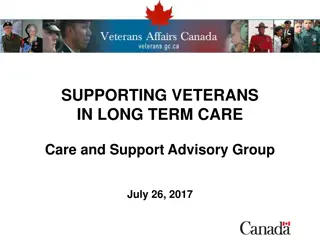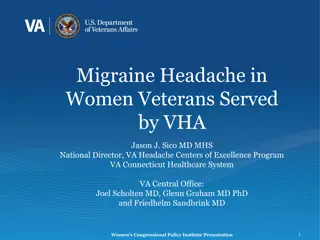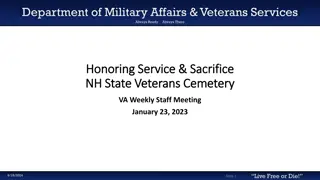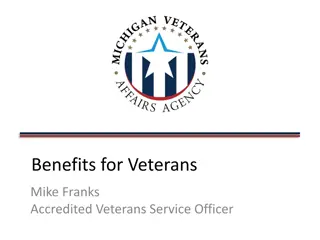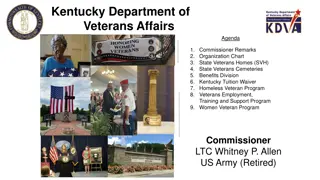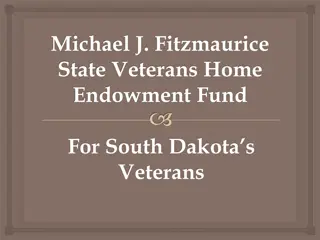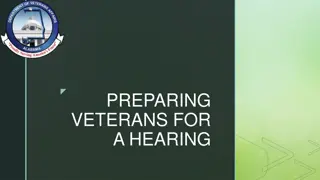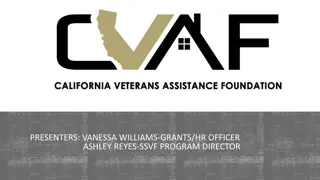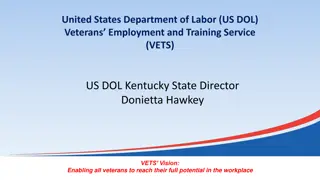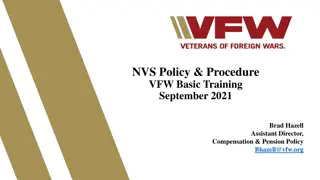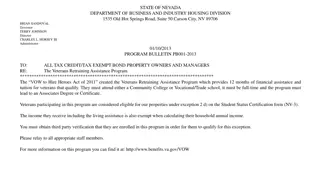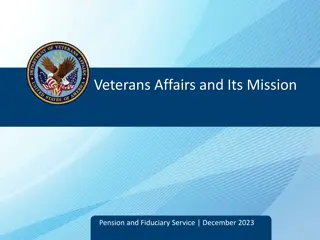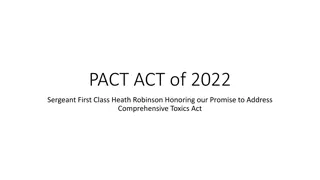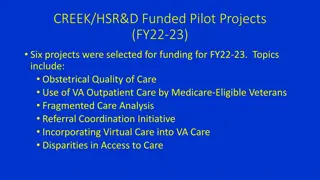Engaging OEF/OIF/OND Veterans in VA Research Through Moderated Focus Groups
This webinar conducted by Tracy Wellens, Ph.D., focuses on the importance of using moderated focus groups to engage OEF/OIF/OND Veterans in VA research. It covers the definition and benefits of focus groups, how they work, and a practical example from Cooperative Studies Program #595. The project aims to understand the impact of support on the health and services of Veterans who served during OEF, OIF, and OND. Key recommendations from the research are also shared.
Download Presentation

Please find below an Image/Link to download the presentation.
The content on the website is provided AS IS for your information and personal use only. It may not be sold, licensed, or shared on other websites without obtaining consent from the author.If you encounter any issues during the download, it is possible that the publisher has removed the file from their server.
You are allowed to download the files provided on this website for personal or commercial use, subject to the condition that they are used lawfully. All files are the property of their respective owners.
The content on the website is provided AS IS for your information and personal use only. It may not be sold, licensed, or shared on other websites without obtaining consent from the author.
E N D
Presentation Transcript
Engaging OEF/OIF/OND Veterans in VA Research through Moderated Focus Groups April 27, 2016 I 11:00 AM 12:00 PM PT Seattle Epidemiologic Research and Information Center (ERIC) VA Cooperative Studies Program (CSP) Epidemiologic Center Presenter: Tracy Wellens, Ph.D. Gnosis Research pidemiologic esearch and nformation enter
Webinar Outline What is a focus group? Why conduct focus group research? A practical example: Cooperative Studies Program (CSP) #595 Example findings Key recommendations
What is a Focus Group? A focus group is a form of qualitative research. A group of people are asked about their perceptions, opinions, beliefs, and attitudes towards concepts, ideas, products, services, and even processes.
How Does a Focus Group Work? Usually there are between 4-12 participants. Larger or smaller groups can be done depending on the topic, logistics, and research budget Caution against groups that are too large Participants generally sit at a round/rectangular table and questions are asked by a moderator. This is an interactive group setting where participants are free to talk with other members of the focus group. These can be conducted in focus group facilities (benefit of a one-way mirror) or any meeting room.
Benefits of Conducting Focus Groups Often used before quantitative research to identify issues that may impact those more expensive and comprehensive projects. Allows for a more in-depth conversation to uncover the why s to peoples perceptions and reactions. Allows for iterative changes to be made to descriptions or materials, to evaluate their impact.
A Practical Example: CSP #595 Focus Group Research Project
CSP #595: Background Objective: Characterize the impact of support during Operation Enduring Freedom (OEF), Operation Iraqi Freedom (OIF), Operation New Dawn (OND) on the health and service of Veterans Population: Veterans who served during OEF, OIF, and OND Deployed and non-deployed Veterans VHA and non-VHA Users
Practical Example: CSP #595 Focus Group Research The Goal: To better understand what is most important to Veterans when they are deciding to participate in research studies in order to improve a Veteran s likelihood to participate. Designed to Gain Insights on the Following: To understand how Veterans feel about participating in health- related VA research Suggestions on how to improve the invitation process Evaluation of specific materials related to CSP #595 research: o Invitation process o Logos o Study description o Compensation models o Information sharing
CSP #595 Focus Group Research: More Specific Goals To Understand: Veteran s motivations for participating in research General perceptions of health-related Veteran research Evaluation of CSP #595 recruiting materials and process Key incentives to increase participation Value of data sharing
Focus Group Methodology Conducted in 5 cities from September November 2015 2 groups per city with participants who would be qualified for CSP #595 based on the dates and location of service People within a 30 mile radius of the focus group locations were invited to participate A total of 89 people participated in the research Seattle, WA Houston, TX Long Beach, CA Minneapolis, MN Atlanta, GA TOTAL 7 0 0 0 8 15 Women 11 6 Male, Enlisted 10 0 10 0 37 Male & Female Enlisted 0 8 12 0 0 20 0 7 0 0 10 17 Officer, Male 17 15 22 17 18 89 TOTAL
A Practical Example CSP #595: Motivation for Participating in Research Pros and Cons from the Participant Perspective Question Areas Why are you or aren t you interested in participating in health-related research?
Motivations to Participate in Research To Help Fellow and Future Veterans: Veterans talk about duty, honor and doing the right thing . They feel it is their continued duty to help others still in the service. They do it for their brothers and sisters in arms and for the common good. Several brought up research related to Agent Orange in Vietnam and how it helped that generation of Veterans. They equate that research with this research on burn pits in Iraq and Afghanistan. Some interest in interacting and sharing experiences with other soldiers from their era which motivated them to participate (particularly in this Focus Group setting). In Their Own Words: o It s our duty to help other Vets. There are still people over there and it may help o Whatever I can do to help my brothers and sisters, I ll do o Look how long it took for Agent Orange illness to be understood, we have to be part of the research about Iraq/Afghanistan o I like being around other guys who were also there...we have a bond
Motivations to Participate in Research Compensation: The incentive is noted and appreciated. Many state they need and can use the extra money. o I noticed the money o I noticed the $150 right away (was stated many times) o I want the money but would have done it anyway To Gain Information on Health Status: To see if their health is impacted and should be followed up by their own doctor or they should qualify for additional services. To help find ways to improve the health of their and future cohorts. o After being in those burn pits my nose ran black for days, it can t be good o I have had issues that they can t figure out, maybe this will help them understand what happened and how to treat it o They gave us all of those pills and they know the air quality was terrible and we were exposed to stuff, they are trying to figure it out
Reasons Why NOT to Participate in Research Practical Issues: Veterans evaluate time, distance, and convenience Complex schedules (time required, when required and where) Location (compared to work, kids school/daycare, and home) Parking availability Childcare issues (what to do with the kids and the additional costs involved) Time: o I already gave them a lot of my time and I want to spend my free time with my family o My kids are my priority and I already have enough things that take time away. It really has to be worth it Distance & Location: o I don t want to have to drive far o I don t like traffic o I m not going to a Vet Hospital, it is not good there o Parking can t be hard
Reasons Why NOT to Participate in Research Compensation: They look at the amount of the incentive and decide if it is worth their time and effort. Studies with an ample incentive should have more cooperation and willingness to participate. o If it is enough money, I may go o I should get money for my time Fear: Results from health-related research may impact benefit qualifications. Study results become part of the permanent record. Personal and emotional safety (knowing where it is, what it is about and their level of comfort with the requirements). o Everything is stored in one file so if you don t get a low score they may take away your benefits o I don t want to talk about everything and I am not sure what they will want to know
Feelings About Being Invited to this Focus Group How did it make you feel to be invited to this Focus Group? Participants were happy to participate in the research and felt they were treated professionally and with respect. In Their Own Words: o I felt important to be called and included and to have a chance to help my fellow servicemen and also get information about the VA for myself o Honored o Special o Really glad I could help o It was close to work and at the right time...I was glad I could help o My wife opened the letter and reminded me to call o I m glad they are doing this to try to make things better, the VA really needs help o I was curious about what this was going to be about o Respected for my opinion o Hey, $150 cash I was in and I called right away
General Perceptions of VA Health-Related Research Accept that the VA would do research and did not express concerns about the quality of that research. Their feelings about the VA overall were mostly neutral to positive. There are negative feelings but they seem to be focused more on the quality of care and eligibility for benefits and services they did not seem to carry over to the research we were asking about. In Their Own Words: o I d trust their research. I m sure they know what they are doing o The VA really could do more. When you are disabled it is always a battle to get what you need o Do they have to do it at the VA (hospital)? I hate to go there I am sure there are other community clinics they could use for those of us who don t want to go to the VA o It can be very frustrating to get what you need o I never deal with the VA, I don t have a reason to
A Practical Example CSP #595: Research Recruitment Process Question Areas Invitation Method Distance Location Compensation Preferences
Recruiting Process: Invitation Best way to be contacted? A mailed letter with a phone number and a follow-up phone call was the most preferred method of contact. The letter provides legitimacy and allows people to do their own research and respond when it is convenient for them. The follow-up call allows specific questions to be answered. Many participants commented that the VA staff who handled the focus group calls were knowledgeable, professional and any with reservations about participating were reassured on those calls. Several participants said they had done online research about the focus group research and made sure the phone number in the letter was a legitimate VA number. A call without a letter is likely to go to voicemail. Many people don t answer calls from sources they don t know.
Recruiting Process: Invitation Best way to be contacted? Email was the least preferred method of initial contact. Email is most likely to be ignored and deleted. Veterans get bombarded with offers and marketing materials and they are likely to delete email from sources they don t know. A few people did suggest email contact but it was the minority.
Recruiting Process: Distance How far will I travel to participate? Most people are willing to travel up to one hour if the compensation is acceptable. Distance is really equated to the actual time it takes, the gas (or transportation fees) it requires, and comfort with the location. Actual distance is a proxy for the complexity of the schedule (with work, kids, family) and their ability to get to the location and be away from their responsibilities. They need time to plan and make arrangements for the research appointment. The Answer -- If people want to participate and the compensation is appealing, distance is not a significant barrier. Ideally, the commute would not take more than about an hour and they have advance notice to plan for it.
Recruiting Process: Location There are mixed feelings about the location of the study being at a VA Facility/Hospital. Cons: There are many diverse reasons why some Veterans avoid VA Facilities/Hospitals: Not needing/using them for service Not enjoying the environment Not wanting to see other Veterans in poor condition (worse than their own) Not having convenient locations Issues with parking in many locations
Recruiting Process: Location Suggested Parking Solution We anticipated parking issues so evaluated potential solutions. Reserved or Valet Parking: Mixed feedback. Some people liked the concept of a reserved spot or valet solution, others worried about the inconvenience this would place on Veterans who truly had difficulties getting around. The officer groups mentioned discomfort with this preferential parking option most often. Finding a way to position easy parking while still appearing respectful will be important.
Recruiting Process: Location There are also positive reasons to have research in a VA Facility/Hospital. Pros: VA facilities are known locations and add legitimacy. When people learn it will be a 1:1 study where there is use of medical equipment and medications, they understand the need for this type of location. The objections are easily explained away and in the end only one of the 89 participants said they would not participate if it was in a VA facility. But even for the right compensation, they said they would re- consider it.
Recruiting Process: Compensation Preferences Type of Compensation Cash, Checks, Debit Cards, Gift Cards: People prefer immediate payments but will accept delayed payments, if necessary. Cash is preferred because it is the easiest, immediate and can sometimes help pay for the costs to attend: babysitting, gas, parking. Checks are ok for most people, but some do not have easy access to a bank. If checks are issued, distribution at the session is preferred to mail. Debit cards were not exciting and people talked about the fees associated with using them or VISA type gift cards. Gift cards were valued by women for food and/or gas, but most people felt constrained by their limited use at a particular store.
Recruiting Process: Compensation Preferences Amount of Compensation For in-person studies, $50 per hour compensation, including travel time, seems very acceptable and fair to most people. Some officers expected more like $75-$100 per hour, but would be willing to participate at $50. Less money to do a questionnaire at home is also ok and expected. Compensation amounts under $25 carry little weight and aren t appealing. But again, people say they primarily participate to be helpful and support their fellow Veterans.
A Practical Example CSP #595: Evaluation of Recruitment Materials Question Area Invitation Letter Logos
Recruiting Process: Invitation Letter Evaluation Able to obtain feedback on tone, word choice, and understandability of the invitation. Determine what information is critical to making the participation decision. Overall Feedback Includes: The 5 W sare crucial: who, what, when, where and why should be easily deciphered. Don t use too many words and leave a lot of white space. People don t want to read dense letters. Future suggestion: evaluate a letter that uses concise language with a bulleted list.
Recruiting Process: Introduction Letter Opening Paragraph: We are inviting you to take part in a research study called, Service and Health During the Iraq and Afghanistan Era, sponsored by the Department of Veterans Affairs (VA) Cooperative Studies Program (CSP). This research is being done to better understand the health of Veterans who deployed in support of Operation Enduring Freedom (OEF), Operation Iraqi Freedom (OIF), or Operation New Dawn (OND). Your participation may provide information that will improve the lives of others in the future. Opening with you are invited to participate sets the tone of professionalism, respect and makes people feel special and important for the process. Including the cohort names (OEF, OIF, OND) helps people connect to the research project because they know it is relevant for them and their cohort. Clearly stating that the research is being done to better understand the health of Veterans of these specific cohorts makes people feel the study is important and has a purpose that they can contribute to.
Recruiting Process: Introduction Letter Concluding Paragraph: We encourage you to call us if you have any questions or would like additional information. If you do not want to take part in this study, please return the enclosed Opt-Out Form or call and let us know. If we do not hear from you, we will try to reach you again by mail and by telephone. People noted that the Opt-Out concept seemed totally wrong. People who don t want to participate also don t want to call or fill out a form. When the Opt-Out concept was explained they understood why they would need to initiate it or they could get follow up reminder calls or letters -- but most said they would not take an action to Opt-Out. They would just not answer calls or throw away future letters if not interested in participating. One or two also said they would not want to pay postage so perhaps including postage free envelops for return opt-out forms would be nice. A few also mentioned it would be helpful to include an online opt-out link in the letter too.
Recruiting Process: VA Logo Evaluation 1 2 3 Logo 1: The least favorite. It was viewed as outdated, clip-art, cartoonish, not cool and easily, fraudulently copied. It was recognized as mostly used in the VA facilities -- another negative for some. Logo 2: Feels more official because it has a color seal that makes it seem important. It also clearly states who it is. Logo 3: Is very recognizable, well liked and clearly states who it is from. This was the logo used on the focus group invitation envelop so people tended to have a preference for this logo. Most people mentioned that they opened the focus group invite because it came in a large, non-standard envelop with an official logo (logo 3).
Recruiting Process: VA Logo Evaluation 1 2 3 4 None of the CSP logos were recognized and the name of the program has no meaning to participants. Some liked including the OEF, OIF, and OND but several had no idea what OND was. Version 1 had pull because they had seen it in focus group invite materials. Version 2 people liked the honors but the rest did not have meaning and it did not seem to be specific enough to the 3 operations like logos 3 and 4. Version 3had a design people didn t like with the three O s aligned. Version 4 had some pull because it provided text that made it clear what it was and the eras that were included.
Focus Group Invitation Materials: What matters most? What caught your attention and caused you to open the invitation to the focus group? Veterans consistently talked about the following: The size of the envelope (it was large and not the usual color) The logo made it look important What made Veterans call to participate: The amount of compensation The location The amount of time required for the compensation Those who wanted to participate spent more time evaluating if they could make the logistics of participating work, rather than deciding based on the requirements of the study itself. Priority was placed on: Can I get there for that timeframe? vs. What they are going to ask me to do? The what is important but at initial consideration, it was secondary to the can I make it.
A Practical Example CSP #595: At Home Questionnaires & Forms, Consent Forms and Participation Requirements
CSP #595 At Home Questionnaire Requirements Questionnaire Length: Most said 20-30 minutes is the max amount of time they can tolerate. For compensation they are willing BUT: they get bored, distracted and start to just check boxes to get them completed. Accuracy is suspect if it takes too much time. If longer questionnaires are required (1-2 hours) they want 2-3 weeks to complete them before the session. They would rather have an interview than self-report questionnaires. Interaction with interviewer pleasant. Helps to alleviate stress about recalling anxiety-provoking and unpleasant events. Many people indicated that they have already given enough time to the military. No tolerance for redundant information requests. Annoyed because they feel they should be able to spend their time now in other ways many family focused.
CSP #595 At Home Other Form Requirements Military Log: Collecting a very detailed log of where people were and for how long is going to be problematic for the following reasons: Depending on number of deployments you may be asking for a great deal of information. Veterans knew the month, year and location of each deployment but any other specificity is a guess. Some people have records they can look up, but they were not inclined use them. Air force said the task is very daunting because they are in and out of locations for hours. Sometimes they would not know how to reply. Stress inducing: Remembering things to this level of specificity is upsetting to many Veterans. Several said they just did not want to do it and/or would estimate.
Health-Related Research with Veterans: CSP #595 Recruiting Process: Consent Form Summary Evaluation The consent form, while thorough, is also dense. For the sake of time and consistency, we provided this outline of some of the key information we wanted to evaluate with participants. Location and timeframe were well understood from the letter. There were questions about some of the terms and procedures that will be discussed on the following slides: Questions about stressful situations Pulmonary function test Bronchodilator Drug
Recruiting Process: CSP #595 Consent Form Evaluation In-Person Visit Requirements: Feedback was mostly positive and people seem willing to participate at a VA facility. Providing health metrics like height, weight and pulmonary function were not an issue. Combat and stressful situation questions will be ok in this context. When we get into the details of the consent form, the questions were primarily about the length of time. o How long can it really take to get height, weight, and blow in a tube? Lay people are not familiar with pulmonary function tests, so the pre-post nature of the test and the standard use of a drug and a machine need to be explained. Providing a session itinerary in the materials may help people understand exactly how their time will be spent.
Recruiting Process: CSP #595 Consent Form Evaluation The Drug: There were also questions about a bronchodilator. Many people do not know what this is or that it is the drug mentioned. The words are not interchangeable to lay people. This term sounds very medical and for some it made the test seem even more invasive. There are also questions about the drug. What is it? Why is it needed? Is it experimental? Providing the name Albuterol made most people feel at ease, but not all. This is a drug many are familiar with and some use. Others still worry about reactions and adverse interactions with other medications they currently take. Explaining the pulmonary protocol and that this drug is part of that standard process may help as well. Providing a link to additional information, and perhaps including a fact sheet (like you would get at a pharmacy) about Albuterol would be helpful.
Recruiting Process: CSP #595 Consent Form Evaluation In Their Own Words: o I don t want to take any experimental drugs, even for $250 o I know what albuterol is, it s an inhaler o Albuterol can still make your heart race o Now I know why they need to do it at a VA Hospital o I would still do it o It s a standard test, we ve done them before o They must be worried about our lungs because of the burn pits and the other stuff we were exposed to in the sand o I feel better knowing it s just albuterol o Why don t they just say it s albuterol instead of a drug, sounds like some experimental stuff that we don t want without the name o Why can t they use simple language and explain it better.. broncowhat? o It seems pretty simple
Recruiting Process: CSP #595 Consent Form Evaluation Purpose of Study: While from a research perspective it is clear why you do not want to disclose too much about the study s purpose, it feels like there is a secret. People seem uncomfortable because there seems to be an unstated assumption that there may be potential pulmonary issues and Veterans who were deployed in Iraq and Afghanistan and that is the reason for the research. Veterans mention burn pits and other toxic substances from the ground and air. They also mention medications they were required to take. They know they were exposed. Thus, it feels like there is an elephant in the room in relation to the invite letter and materials and perhaps it should be addressed if possible.
Recruiting Process: CSP #595 Consent Form Evaluation Purpose of Study: Somehow the study description seems less sincere because these issues are not outlined. Perhaps including something about experimental design and acknowledging the issue would be helpful and make the study seem less secretive and more honest. For example: We are studying pulmonary function in this group of deployed Veterans because we want to determine if there are function differences due to exposure to environmental elements. Therefore, we need people who were and people who were not exposed for the research to be meaningful. There was nothing in the focus group research that suggests people will only participate in research that is directly related to their own health issues. They want to participate and will if the description, timing and compensation make it feel valuable and do-able.
A Practical Example CSP #595: Data Sharing Feedback Closing the Loop
CSP #595: Data Sharing Feedback What matters most? Most of all people want to know that the research had an impact and that the results will help other Veterans. Believing they assisted in one study will likely impact their willingness to participate in other research in the future. They seemed delighted that some results could be shared.
CSP #595: Data Sharing Feedback What matters most? Individual Results: People would like them but aren t expecting them. Veterans are interested in their own health and are curious about why these particular health topics are researched. They believe they must be selected for a reason (e.g., they were exposed to something and now they may have an issue). They want simple explanations so they can understand if they are in the normal or abnormal range. They are hoping this information may help them qualify for treatment or services. Veterans are still interested in these reports even if they have to wait for them and they are not official test results. They want to share them with their doctor if follow-up is suggested or just keep them on file.
CSP #595: Data Sharing Feedback Cohort Reports: Veterans are interested to see how they compare to their own and other similar cohorts. In addition, cohort info is also helpful for them to take to their doctor if they have odd symptoms. It may help guide their own treatment or help them qualify for treatments. Final Study Reports: Veterans would like to see the learnings and impact of the research they participated in. Some would like the full publications, but many prefer a lay summary with practical suggestions. They talked about showing these to friends/family/other Veterans to demonstrate what they participated in. They are happy to go to a URL to download it.
Health-Related Research with Veterans: Additional Observations
Key Points to Remember to Make Study Invitation Materials Appealing What matters most for participating in the VA health- related studies: Feeling like they are honorable and continuing to do their duty as participation may help improve the health of other Veterans from their cohort and hopefully future cohorts. Fair compensation (they like the cash). Wanting to learn about their own health and issues that may face their cohort. Inviting them in the right way makes them feel important, special, respected and valued.
Other Requirements That May Impact Participation What matters most for participating in the VA health- related studies: For the right compensation, most metrics we discussed, including providing bodily fluids, were not viewed as too invasive. People in the military say they are used to being poked and prodded. Many seemed less happy about answering questions about their combat experience. However, having to take drugs to participate in the research seems to increase the participation barrier. The description we provided of Albuterol alleviated fears and people stated they were willing to participate. Other drugs that are less known, may continue to have a higher barrier to participation.
